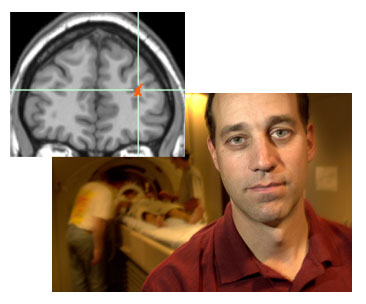Berkeley’s brain behind addiction research
Mark D’Esposito and his team are trying to find the cognitive basis for addiction
![]()
| 29 October 2003
| |  Professor Mark D’Esposito (above, foreground) oversees research into the neural functioning of drug and alcohol addicts, relying heavily on scans produced by the campus’s powerful magnetic resonance imaging scanner (behind him). Top left: Brain activity during a stimulus-response learning task in a subject with no history of drug abuse. Strong activation is seen in the right middle frontal gyrus, an area that has been shown to be metabolically abnormal in substance abusers. Researchers predict that when this study is repeated using subjects with a history of cocaine addiction, they will show impairment that will correlate with reduced activity in this brain area. Photo by Noah Berger. Graphic courtesy Mark D'Esposito |
Although drug and alcohol addiction is widely discussed, it is little understood by most. Addicts and non-addicts alike often ask themselves why smokers can’t simply stop lighting up, or why cocaine and heroin addicts continue using, even when they have made a conscious decision to quit.
A group of Berkeley scientists is dedicating itself to understanding addiction’s neural basis, and working toward developing treatments for this widespread public-health problem.
Led by Mark D’Esposito, a professor of neuroscience and psychology, the team of researchers is utilizing several methodologies — including human brain imaging, drug intervention, and cognitive testing — to uncover the reasons behind addictive behavior.
“Our work at Berkeley is different than at other campuses because we are one of the few universities looking at the cognitive reasons for addiction,” D’Esposito says. “Here we have the tools and understanding to delve into the complexities and mysteries of this problem.”
One of those tools is the magnetic resonance imaging (MRI) scanner, located in the Henry H. Wheeler, Jr. Brain Imaging Center. This scanner is the most powerful MRI in the world dedicated solely to brain research.
The MRI clearly plays a large role in D’Esposito’s work on addiction. MRI brain images — stark, white blobs printed on dark paper — litter his desk on the third floor of Tolman Hall. Surrounded by neuroscience books, family photos, baseball paraphernalia, and a brain-shaped lamp, D’Esposito speaks appreciatively of the Wheeler Center, which he directs.
Interdisciplinary scanning?
“The center is special because we don’t have to share the MRI scanner with a medical school,” says D’Esposito. “Also, the scanner encourages interaction with other departments on campus. For instance, a student from the English department contacted me about using the MRI to investigate the neural basis for creativity.”
So far, imaging studies have been conducted on healthy, normal volunteers to establish baselines in brain performance. Subjects are given short-term memory tests, such as memorizing pictures, and their brain activity is measured by the scanner. In the future, D’Esposito will compare MRI images of addicts’ and non-addicts’ brains to isolate differences in their neural mechanisms. Specifically, D’Esposito’s team is looking at activity in the frontal lobes, which are widely believed to be abnormal in cocaine abusers’ brains.
The link between the brain’s frontal lobes and addiction was hypothesized in large part because of the lobes’ high concentration of receptors for the naturally occurring “feel good” chemical dopamine. Dopamine is used by the body as a positive reward — for example, it causes the gratifying satisfaction we feel when our thirst is quenched. Addictive drugs like alcohol, cocaine, or amphetamines essentially cause the brain to experience a flood of dopamine, disrupting the brain’s carefully calibrated communication scheme and natural system of positive rewards. This flood accounts for the surges of elation brought on by drug use. Addicts become slaves to substance abuse because their brains alter themselves to meet the unnatural demands for dopamine brought on by drugs in their bloodstreams.
MRI scanning is safe and noninvasive, and therefore will be a useful tool for gauging the effectiveness of proposed addiction treatments. An effective treatment, for example, may cause an addict’s frontal lobe activity to look more like a non-addict’s.
D’Esposito has been studying the link between dopamine and addiction for some time, beginning at the University of Pennsylvania, where he first started investigating the neurobiology of addiction after receiving a grant from the National Institute on Drug Addiction. He left Pennsylvania after he was invited by Berkeley to direct the Wheeler Brain Imaging Center. The Bay Area also offered D’Esposito the ability to work closely with colleagues at UCSF’s Center for the Neurobiology of Addiction.
The Bay Area’s large population of drug addicts gives D’Esposito’s team access to a pool of test subjects. Charlotte Boettiger, who just completed her stint as D’Esposito’s post-doc, will soon begin the process of recruiting addicts from local clinics, upon whom she can begin running experiments.
Boettiger recently became a research scientist for UCSF’s Gallo Clinic and Research Center, which is dedicated to understanding the neuroscience of alcohol and drugs of abuse on the brain. Data from Boettiger’s tests, which will be performed using the Wheeler Center’s MRI scanner, will be compared with the control data the team at Berkeley has already collected.
D’Esposito, one of hundreds of Berkeley Health Sciences Initiative faculty, hopes his work will lead to a cure for addiction, which may consist of a combination of behavioral, cognitive, or drug treatment.

